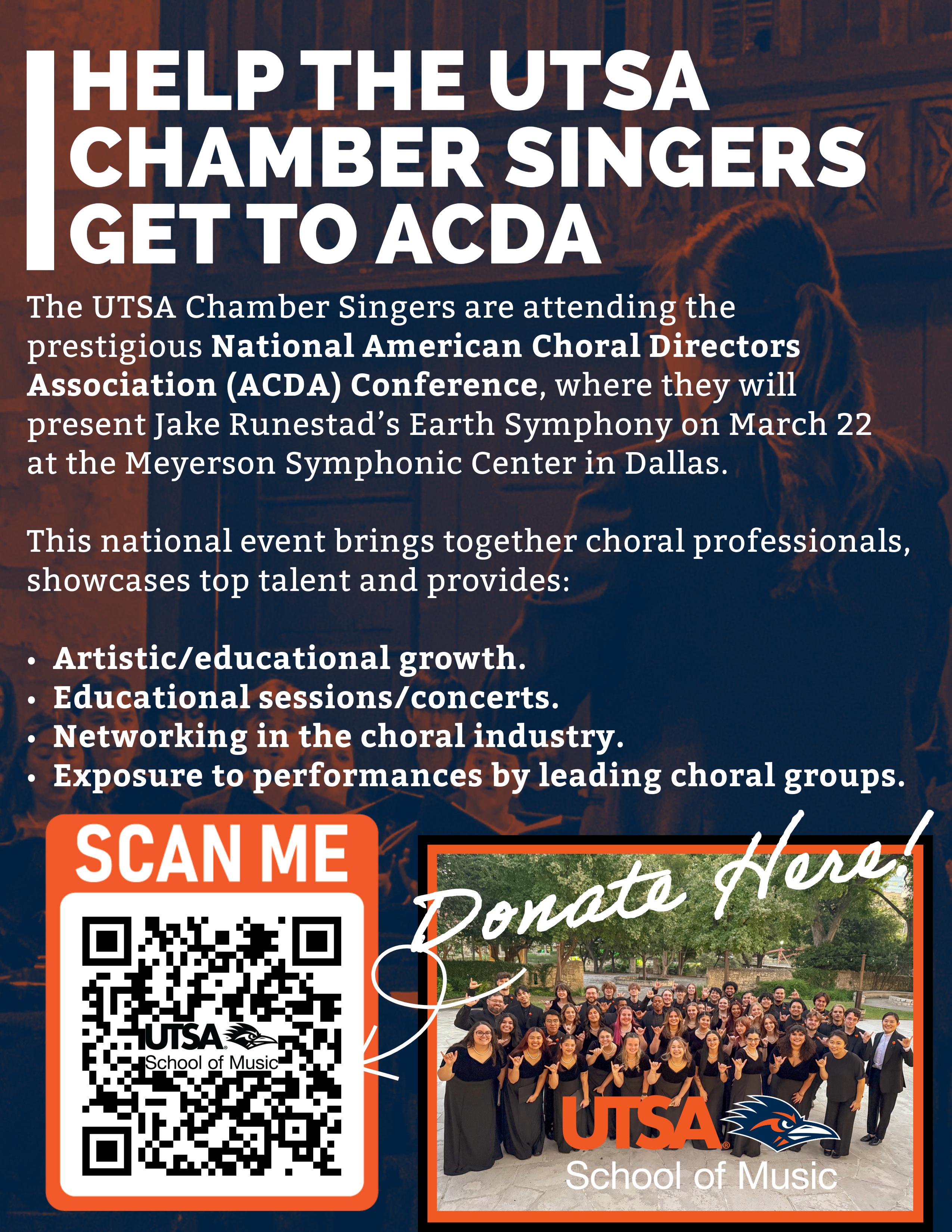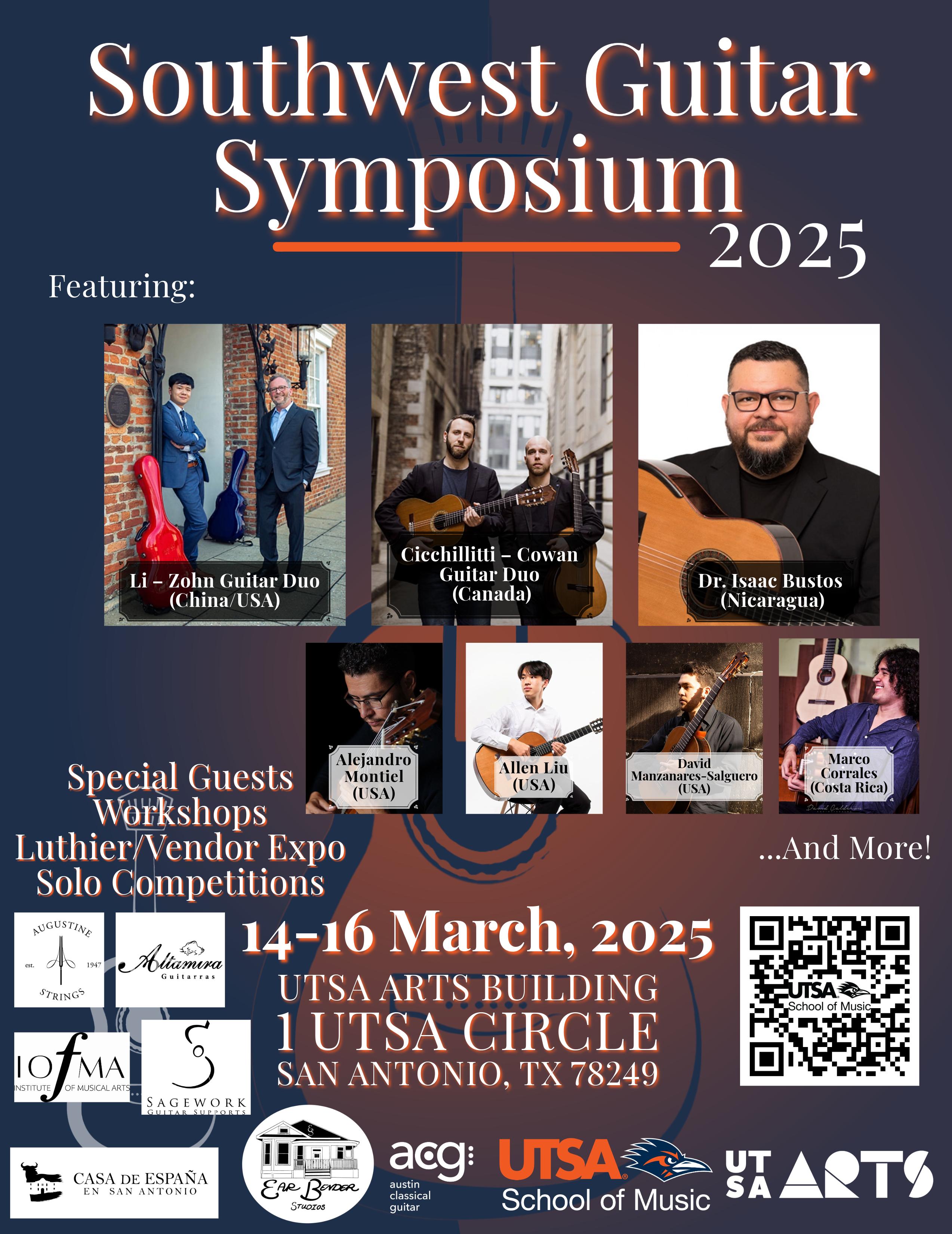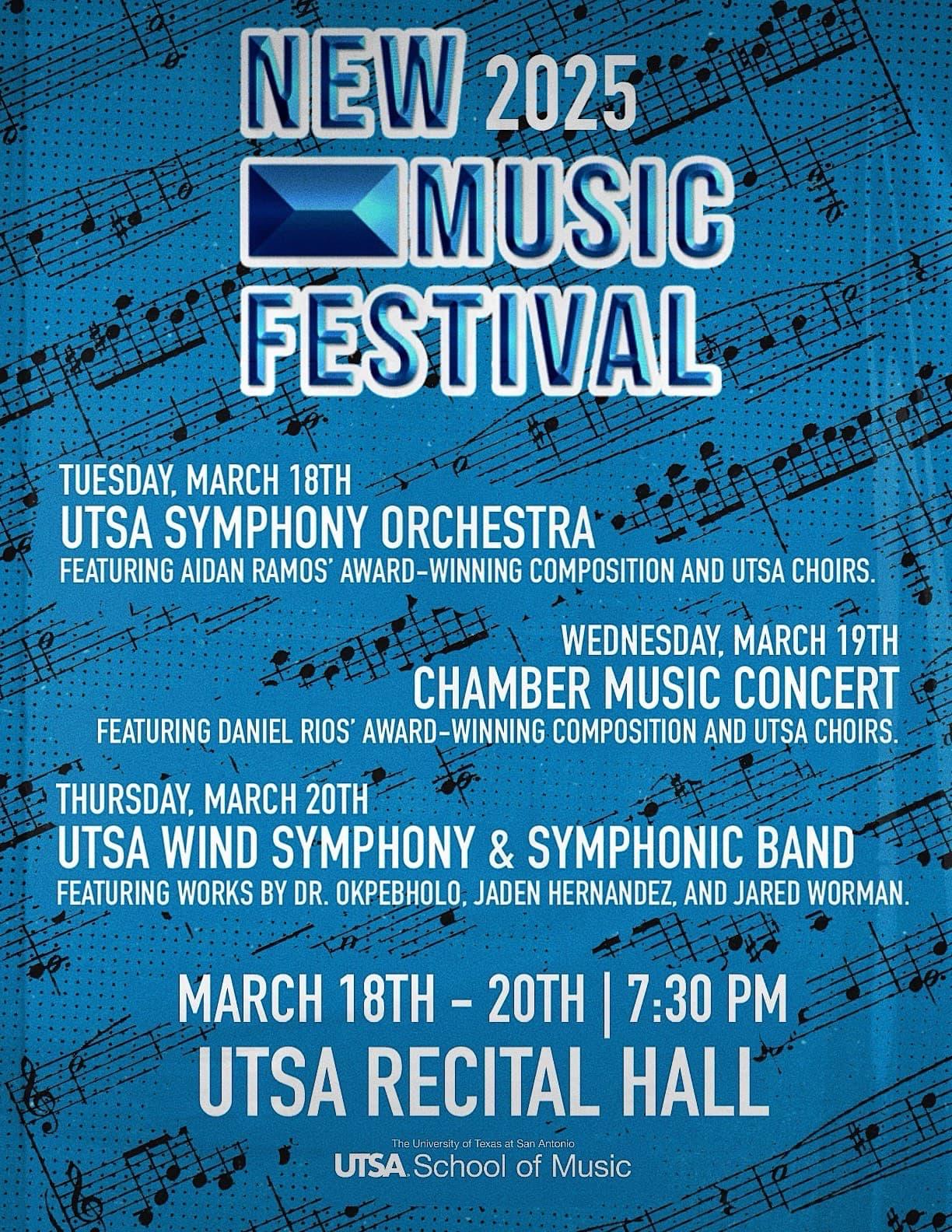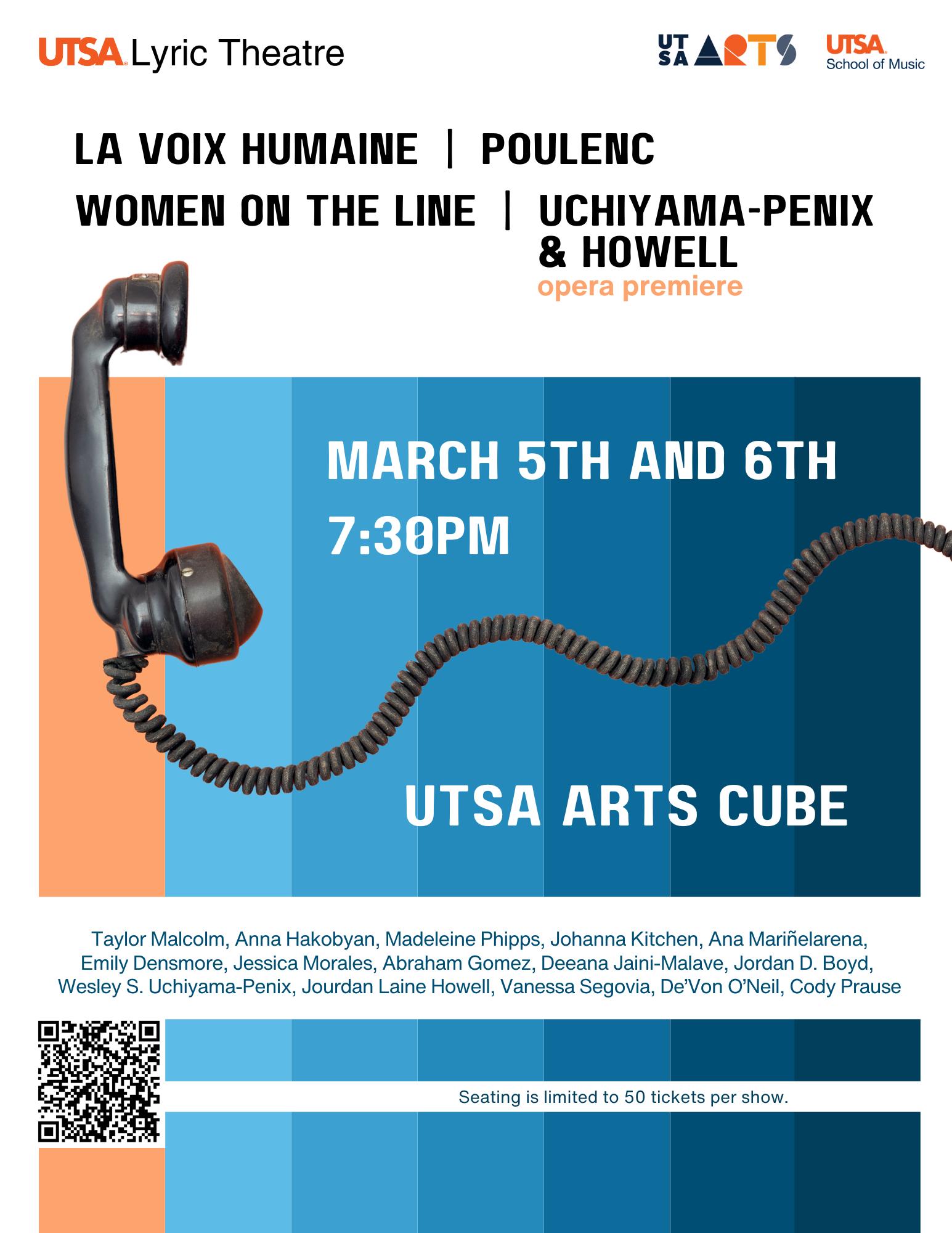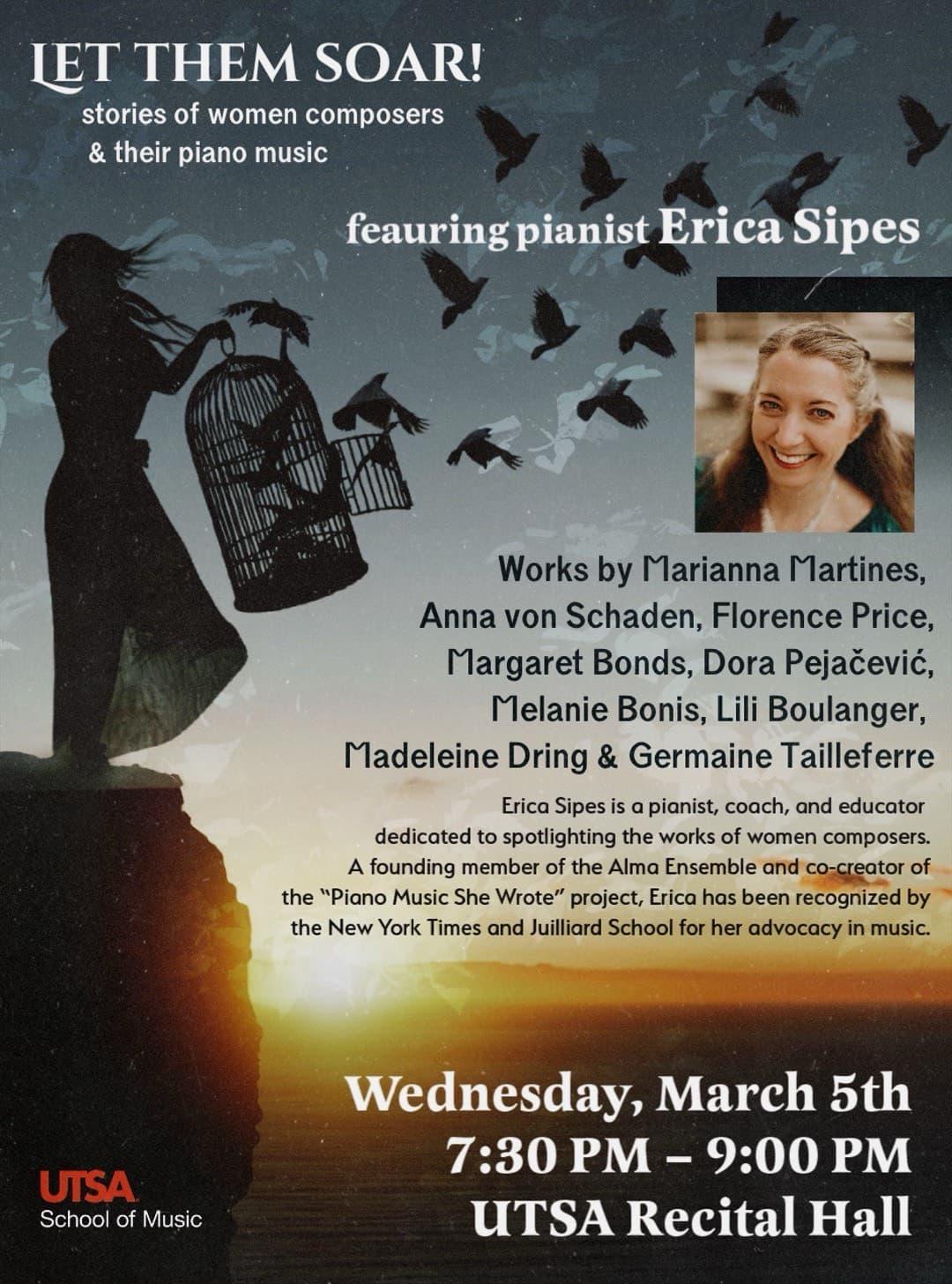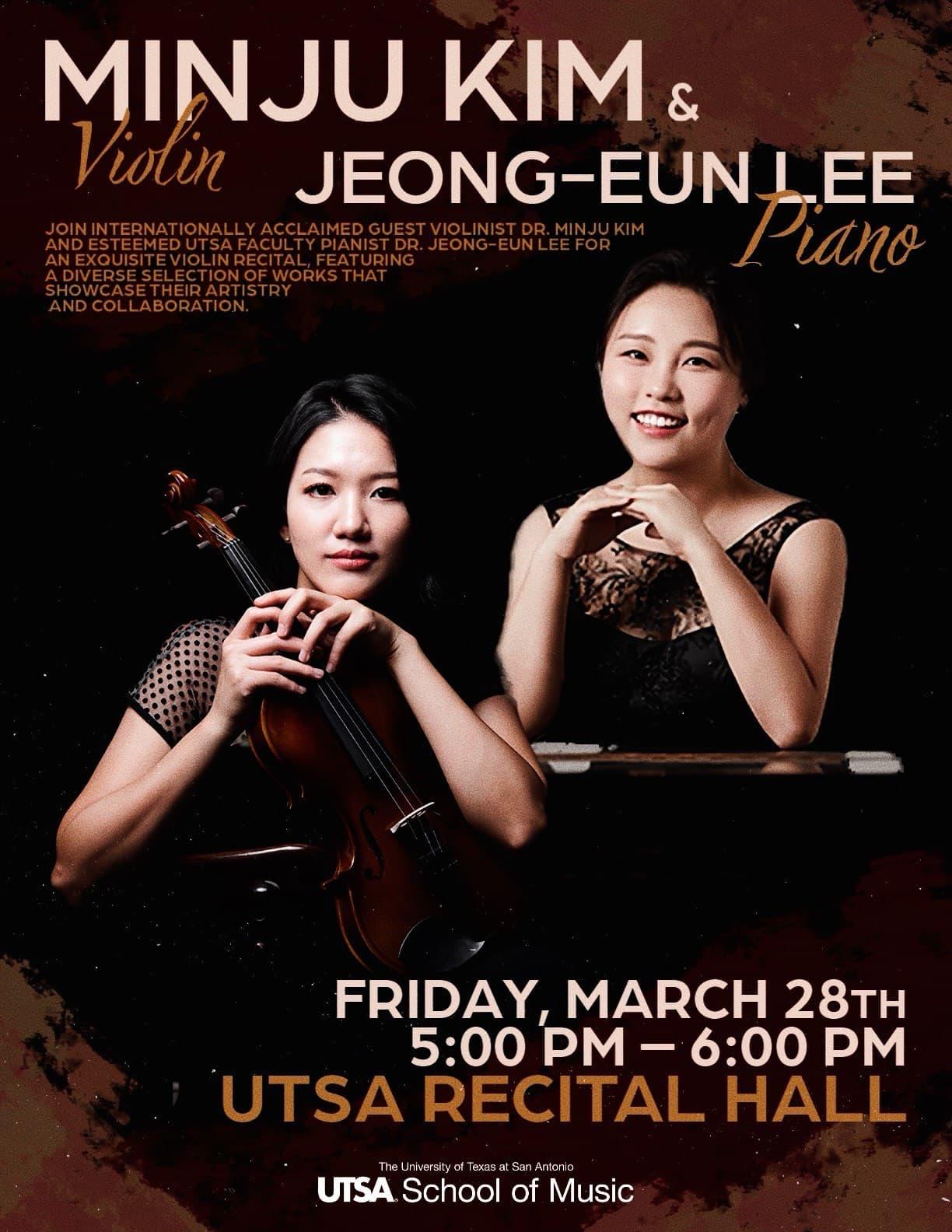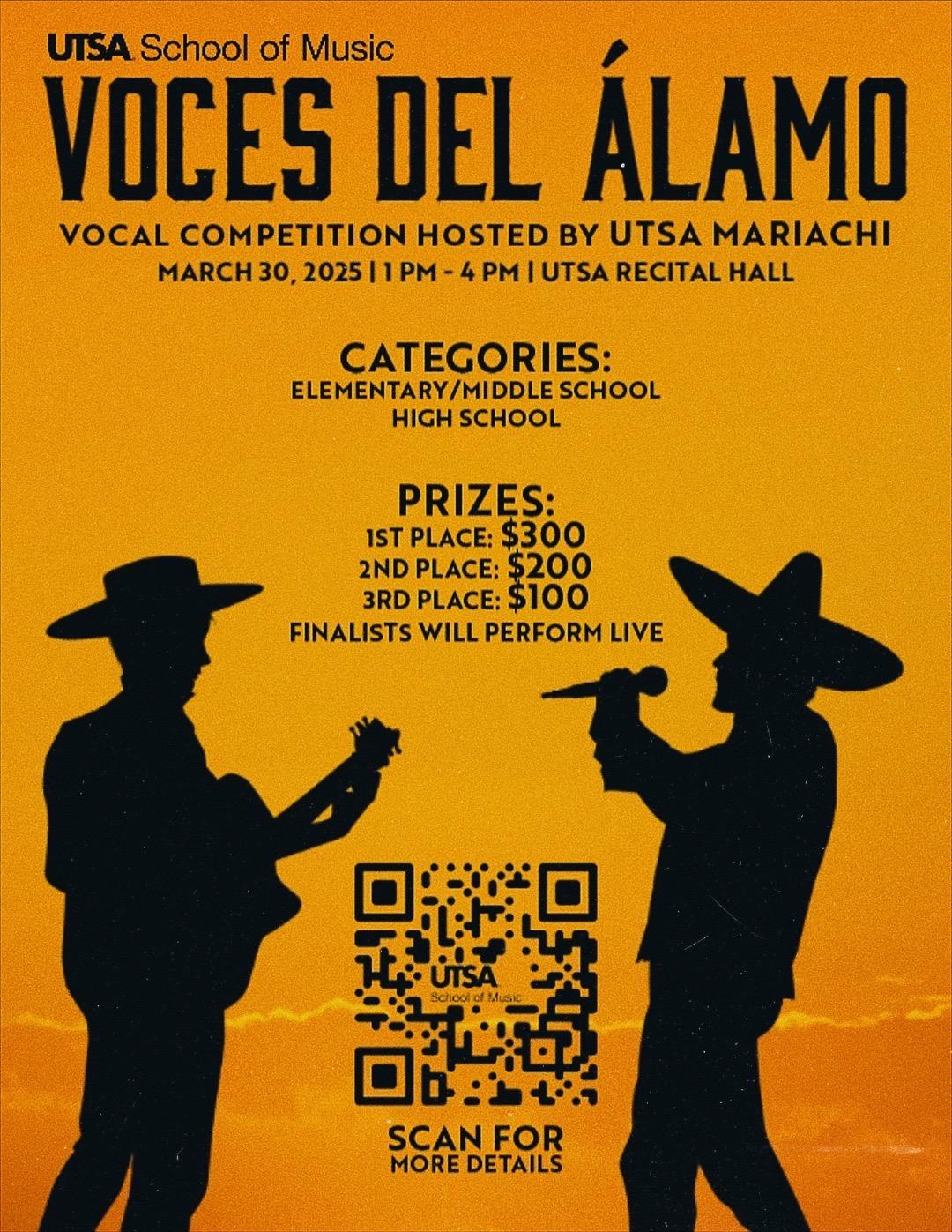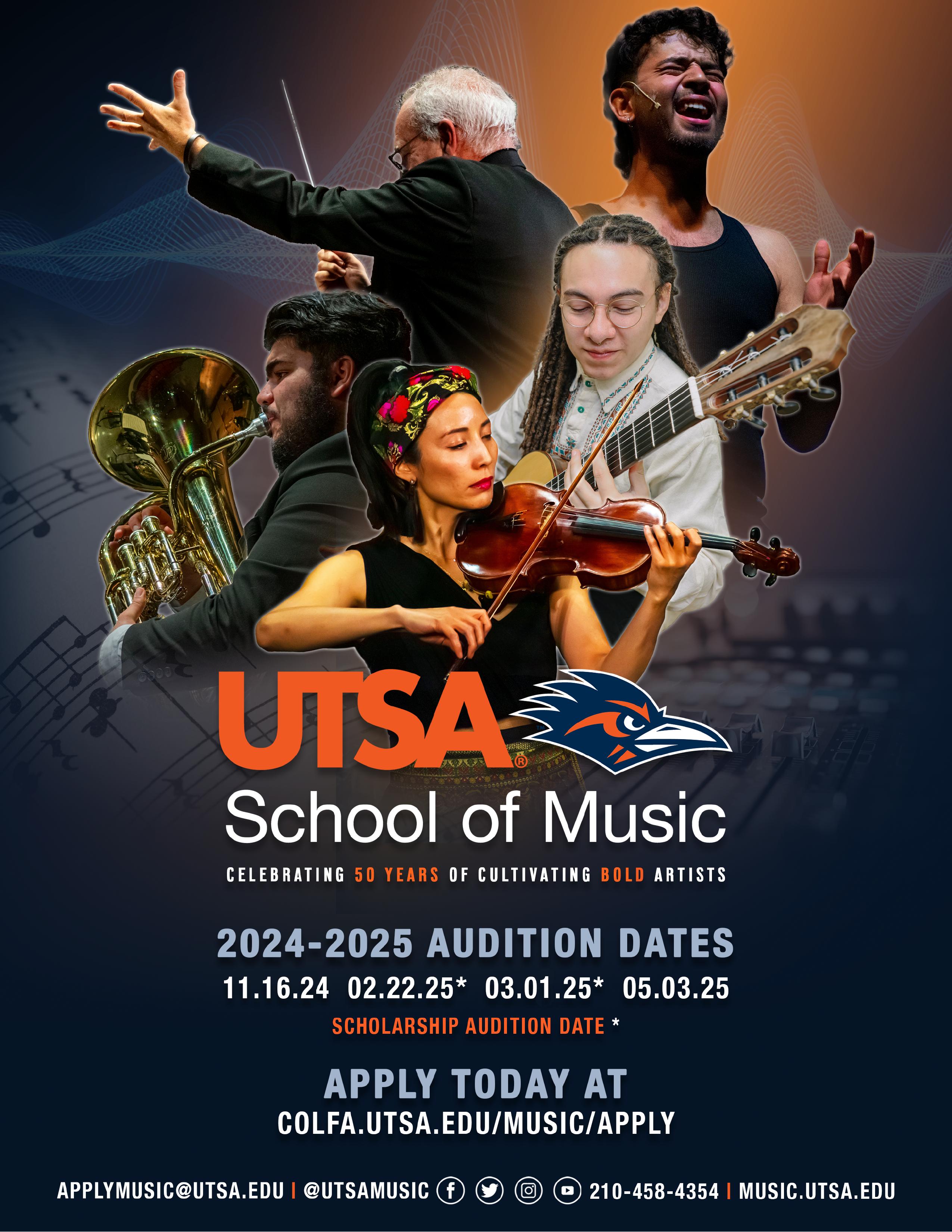Spring 2025 University of Texas at San Antonio Wind Symphony
Flute / Piccolo
Joaquin Carcamo
Jazmine Dearlove
Lauren Garcia
Ana Jaud (G)
Amy Leonard
Oboe
Samuel Coleman
Logan Odom
Bassoon
Jaime Viejo
Jared Worman (also Contra Bassoon)
Clarinet
Sikander Ahmed
Sophie Anderson
Orlando Baron
Kali Crist
Sarah Hamm
Kenedy Lerma
Isabella Miranda
Bass Clarinet
Michael Lee Summers
Alto Saxophone
1 Gabriel Campa
2 Bryson Vincent
Tenor Saxophone
Parker Murray
Baritone Saxophone
Brianna Castilla
Horn
Brandon Bayer
James Gonzales
Caleb Jones
Andrew Ramirez
Myrna Ramirez
Band Staff
Jarred Worman - Music Librarian
Extra Musicians - Jacob Herrera, Richard Myers
Trumpet
Ivan Lorduy-Camargo(GA)
Gustavo Medrano
Anthony Mitcham
Raymon Saldana(M)
Karim Vazquez
Daniel Vasquez
Julian Wegland
Trombone
Eva Ayala(M)
Bradley Bolton
Brandin Castillo
Jayden Zunker-Treviono
Bass Trombone
Javier Lopez
Euphonium
Alex Guzman
Aiden Ramos
Tuba
Matthew Bruns
Kenyon McCrary (M)
Percussion
Matthew Aceves
Emilio De Leon (GA)
Erin Faehnle
Trent Fallin
Rebecca Palmer
Mark Sawyer
Ivan Ventura
Double Bass
Heriberto Ayma
Organ
Scott Rushforth
Piano
Pablo Ventura (G)
Graduate Assistants/Band Managers
Graduate students are listed with (G) above
Graduate Assistants are listed with (GA) above
Band Managers are listed with (M) above
Personnel roster is listed alphabetically to emphasize the important contribution made by each musician.
R o n E l l i s serves as Director of Bands and Associate Professor of Music at The University of Texas at San Antonio. Prof Ellis conducts the UTSA Wind Ensemble, the UTSA Symphonic Band, The UTSA University Band, and the UTSA Athletic Bands. His responsibilities also include teaching graduate and undergraduate courses in conducting, wind literature, and music education. A nationally recognized guest conductor, adjudicator, and composer/arranger, his works for concert band, orchestra and choir are performed by university, community, high school and professional wind bands as well as in Carnegie Hall. He also currently serves as a music director for Walt Disney Attractions Entertainment in Orlando where he has directed the Toy Soldiers and the Student Musician Program since 1993.
He is a member of the College Band Directors National Association, Texas Music Educators Association, Texas Bandmasters Association, Florida Music Educators Association, Florida Bandmasters Association, and Phi Mu Alpha Sinfonia Music Fraternity. He is also an honorary member of Kappa Kappa Psi, Tau Beta Sigma, and Pi Kappa Lambda. Prof. Ellis received his Bachelor of Arts in Trombone Performance from the University of Central Florida and a Master of Music in Wind and Orchestral Conducting from the University of South Florida where he was a conducting student of William Wiedrich.
J o h n S c h n e t t l e r - John Schnettler has been a music educator and conductor at the middle school, high school, and collegiate levels in the public schools of Florida, Georgia, and Tennessee. At APSU, Professor Schnettler is the Director of Bands, conductor of the APSU Wind Ensemble, and teaches courses in Conducting and Music Education.
During his first 14 years at APSU, Prof. Schnettler served as the Associate Director of Bands and Director of Athletic Bands. Under his direction, the “Governors Own” Marching Band (GOMB) enrollment doubled, and is now recognized as one of the most spirited and energized group of students on campus. He also expanded the scope of the annual Mid-South Marching Invitational, founded the annual GOMB Day event, and dramatically increased the level of performance in the APSU Symphonic Band.
Before coming to APSU, Prof. Schnettler was on faculty at the University of South Florida, where he served in various capacities, including Director of the “Herd of Thunder” Marching Band, conductor of the USF Symphony & Concert Bands, and instructor of courses in conducting and music education. He was also a graduate assistant at the University of Georgia, where he instructed the Redcoat Marching Band, supervised student teachers, and guest conducted the wind bands.
Prof. Schnettler holds the degrees of Master of Music in Conducting, and Master of Arts in Music Education from the University of South Florida, as well as Bachelor of Music Education from the University of Central Florida. He is currently pursuing a doctoral degree in Music Education from the University of Georgia.
Prof. Schnettler is an active guest conductor, honor band clinician, and adjudicator, as well as a two-time Co-Director of the Chick-Fil-A Peach Bowl mass band. He has been published three times in the popular GIA Publication series "Teaching Music Through Performance in Band", presented at professional conferences across the country, and was involved with the Drum & Bugle Corps activity as a performing member, instructor, and consultant.
Prof. Schnettler lives in Clarksville with his wife Brandy, a Biologist and Science Educator, and their two daughters.
T h e U T S A W i n d S y m p h o n y
The UTSA Wind Symphony is comprised of UTSA Students who have achieved an extreme high level of musicianship and who perform some of the most challenging music composed for wind band. Membership in this ensemble is open to all UTSA Students, regardless of major, who audition at the beginning of each semester. The UTSA Wind Symphony maintains a vigorous performance schedule of three demanding concerts each semester as well as an ensemble tour when schedule and budget permits.
Compiled and Edited by Ron
Ellis
In the following pages, you’ll find details about each piece, but I wanted to share the deeper significance behind tonight’s program.
Tonight’s program, Past Meets Present, explores the enduring dialogue between musical traditions and contemporary innovation as well as us old peeps (me), literally passing the baton to the next generation.
From the soaring landscapes of Richard Saucedo’s Snow Caps to the intricate textures of Paul Dooley’s Elytra, we witness the evolution of wind band repertoire, bridging past influences with modern creativity.
Claude Debussy’s The Engulfed Cathedral, a timeless impressionistic masterpiece originally composed for solo piano, invites us into a world of mystery and transformation, while Haydn Wood’s Mannin Veen connects us to the rich folk traditions of the Isle of Man. Finally, we close with Karl King’s The Purple Pageant, a classic march celebrating the enduring spirit of the wind band tradition.
This concert holds special significance as we welcome Professor John Schnettler, a former student from my UCF days, and newly appointed Director of Bands at Austin Peay State University. Prof. Schnettler will guest conduct Mannin Veen, sharing his artistry and insight with our students. Seeing him achieve his dream is a deeply meaningful moment, embodying the very essence of tonight’s theme honoring the past while shaping the future.
Richard L. Saucedo is an American composer, arranger, conductor and educator.
Mr. Saucedo was Director of Bands and Performing Arts Department Chairman at Carmel High School in Carmel, Indiana. Under his direction, Carmel bands received numerous state and national honors in the areas of concert, jazz, and marching. The Carmel High School Wind Symphony was invited to the Bands of America National Concert Band Festival in 1992 and 1999, and was named the Indiana State Champion concert band in 1999. The Carmel High School Marching Greyhounds, having been a consistent National finalist since 1995, was crowned the 2005 Bands of America Grand National Champion.
Also in 2005, the Wind Symphony 1 was invited to perform at the prestigious Midwest Clinic in Chicago. The Indiana Bandmasters Association named Mr. Saucedo Indiana's "Bandmaster of the Year" for 1998-99.
Mr. Saucedo is a freelance arranger and composer, having released numerous marching band arrangements, concert band works and choral compositions. He is currently on the writing staff for Hal Leonard Corporation, and is constantly in demand as an adjudicator, clinician, and guest conductor for concert band, jazz band, marching band, orchestra and show choir. He has served as Music Caption Head for the Drum Corps Midwest Judges Guild, and as a brass and music judge for Drum Corps International.
Mr. Saucedo did his undergraduate work at Indiana University in Bloomington and finished his Master’s degree at Butler University in Indianapolis.
Commissioned by the 2004 Jefferson County Honor Band, Denver, Colo., and drawing musical inspiration from the awe-inspiring surrounding mountain peaks, S n o w C a p s from Richard Saucedo explores a wealth of colors and emotions possible with today's wind orchestra. At times sensitive and delicate with soloistic passages, and alternately incessantly rhythmic and powerful, this composition displays complete command of the idiom and a creative sense of harmony and form.
- Program Note from publisher wuw
D o o l e y is an American composer and music educator.
With the passionate guidance of two musically progressive parents, he began his musical career by playing in a wide range of genres: from drum set and piano in rock and jazz groups to orchestral percussion. At age 12, he began studying composition and improvisation with Doc Collins, and later with Charles Sepos.
Dr. Dooley earned a degree in music composition, and a second bachelor’s degree in mathematics, at the University of Southern California, where his mentors included Frank Ticheli, Stephen Hartke and Frederick Lesemann. Dooley completed a master's and a doctorate in composition at the University of Michigan, where he worked primarily with composers Michael Daugherty, Bright Sheng and Evan Chambers.
Paul Dooley is one of the most prolific and performed composers in America today. His path has embraced not only his Western Classical heritage, but also a crosscultural range of contemporary music, dance, art, technology and the interactions between the human and natural worlds.
A key moment occurred for Dooley in 2010, with his participation in the inagural Mizzou International Composers Festival. The festival commissioned Dooley's breakout work Point Blank, which was premiered by the new music ensemble Alarm Will Sound.
In 2013 Dooley joined the music faculty at the University of Michigan. He created and directs the Performing Arts Technology department’s annual Computer Music Showcase. He also co-directed the Midwest Composers Symposium and was coordinator of the “ONCE. MORE.” festival, a celebration of the 50 year anniversary of the ONCE Festival of Contemporary Music, and was co-awarded a grant from the Gilbert Whitaker Fund for the Improvement of Teaching.
Dooley is a frequent guest of professional orchestras, university wind ensembles and festivals in the United States and around the world. His works have been performed in significant venues including Carnegie Hall, Walt Disney Concert Hall, Royce Hall, and Chicago’s Symphony Center, and featured on several episodes of NPR’s “Performance Today” with Fred Child.
Dr. Dooley has received a wide range of awards for his work, including both the 2016 Sousa/ABA/Ostwald Award and the 2015 William D. Revelli Prize for Masks and Machines (2015), the 2013 Jacob Druckman Award for orchestral composition from the Aspen Music Festival for Point Blank (2011), and young composer awards from Broadcast Music Inc. (BMI) for Dani’s Dance (2007) and the American Society of Composers, Authors and Publishers (ASCAP) for Gradus (2009).
E l y t r a was commissioned by the United States Navy Band, conducted by Captain Kenneth C. Collins for their 2022 Midwest Clinic performances and 2023 National Tour.
Originally I was inspired by the incredible naval aviation technology of the F/A-18F Super Hornets and F-14 Tomcats. But in my research I discovered the equally impressive biological mechanics found in nature’s aviators like the fireflies, ladybugs, and other beetles. They possess elytra, a remarkable set of high-strength, lightweight wings that both protect the body and facilitate flight.
The elytra soundscape “took flight” with muted brass clusters, pulsating augmented chords, scraped cymbals and bluesy melodies. In the dark middle section, I imagine one of our beetle friends burrowed into tree roots, before lifting off again, buzzing along close to earth at a high rate of speed.
- Program note by composer wuw
C l a u d e D e b u s s y was born in St. Germain-en-Laye, France and passed away in Paris. He was admitted to the Paris Conservatorie in 1872 where he first studied piano with Antoine Marmontel and solfège with Albert Lavignac. He eventually studied composition with Ernest Guirand and served as an accompanist for the Concordia Choral Society where he worked with Charles Gounod. Debussy won the Prix de Rome in 1884 for his cantata L’enfant prodigue. This enabled him to study for two years in Rome. His early music was influenced by Richard Wagner, but this changed when he heard a Javanese gamelan at the Universal Exposition of 1889 in Paris. Debussy had his largest compositional successes in the next two decades with works such as Prélude à l’aprèsmidi d’un faune (1891-4), Pelléas et Melisande (1893-1902), La mer (1903-5), and Images (1905-12). His music is labeled as impressionist, but Debussy disputed this during his lifetime. He was influenced by artists, painters, and poets labeled variously as symbolists, fauvists, and impressionists. Ultimately, Debussy developed his own style in music by using modes, octatonic and whole-tone scales as well as being influenced by music from India, Russia, and Indonesia.
M e r l i n P a t t e r s o n is a Texas-based transcriber and arranger, primarily of classical symphonic composers.
Claude Debussy's Preludes are a pinnacle of Impressionism, each based on some fleeting or lasting image. T h e E n g u l f e d C a t h e d r a l imagine Brittanic legend, in which the Cathedral of Ys is swallowed by the sea as a punishment for the sinfulness of its patronage. Each morning, as the townspeople watch transfixed, the cathedral would slowly rise out of the sea at sunrise and be subsequently overwhelmed by the waters again as a grim reminder. Debussy captures this image deftly, with his ability obscure metro structure through thick textures, extended and modal harmonies and unconventional rhythms. The three parallel arching structures that comprise the piece slowly reveal the long outline of a tonic triad *G,E, and C major), symbolizing the slow and inevitable descent of the cathedral until it reawakens upon the next sunrise.
- Program Note from University of Georgia Wind Ensemble concert program, 26 March 2009
Haydn Wood was a British composer and violinist. At the age of two Wood and his family moved to the Isle of Man, a self-governing Crown dependency, located in the Irish Sea at the geographical center of the British Isles. The island was often a source of inspiration for the composer. At the age of 15 he studied the violin with Enrique Fernandez Arbos and composition with Charles Villiers Stanford at the Royal College of Music.
In 1909, he married soprano Dorothy Court whom he had met while they were both students at the Royal College of Music, and from 1913 to 1926 he toured extensively with her. Their act consisted of songs and ballads of his own composition, and well loved violin gems. Together with their pianist, he accompanied her on his violin while she was singing. He also gained considerable success from his works, particularly his "light music" and his songs.
Occasionally, Wood would take to the podium, usually to direct his own compositions. He was given his own program by the BBC on the occasion of his 70th birthday, and starting in 1939 he served as a Director of the Performing Rights Society. His final years were spent in relative peace and quiet, and he eventually died in a London nursing-home two weeks before his 77th birthday.
Douglas, the capital of the Isle of Man, was a holiday mecca in Victorian times for people from Northern England. Even before Haydn Wood (1882-1959) was born, his family had regularly journeyed there from Slaithwaite, Yorkshire. At the beginning of the 1885 tourist season, Haydn's elder brother Harry was hired as leader and soloist of the large orchestra at the Falcon Cliff Castle in Douglas. That summer, Sabra Wood brought the entire family, including her little son Haydn, age 3, to proudly watch and listen to Harry and the orchestra. From the age of 7, Haydn studied the violin with Harry. He loved being a member of Harry's Students Orchestra and performed regularly on the Isle of Man.
By the late 1920s, Haydn Wood was becoming known as a conductor of his own music, and he conducted concerts at the Palace from then and throughout the 1930s. On June 19, 1927, in a huge Manx (the common demonym for the Isle of Man) Celtic Concert in which Harry was greatly involved, he conducted the Palace Orchestra in A Health to All Who Cross the Main for baritone, chorus and orchestra, with lyrics by Manxman Henry Hanby Hay, which he had composed expressly for the Manx Homecoming Celebration.
It was not until 1931 that Haydn Wood started composing his large-scale Manx orchestral pieces. The first of these to be played in Douglas was Mannin Veen, on July 9, 1933, conducted by the composer in an exciting concert which included the second and third movements of his new Concerto for Violin, performed by the Spanish violinist Antonio Brosa with the Palace Grand Orchestra. Mannin Veen was eventually published in 1937 and is a classic band work of the post-Holst, preHindemith era of band works; it draws on the composer’s experiences of Manx culture when his family lived on the Isle of Man, this autonomous island situated between Ireland and the English mainland in the Irish Sea. The composition exhibits both symphonic grandeur and Celtic tunefulness, often featuring the principal clarinet.
On the occasion of the first BBC broadcast in February 1933 of Mannin Veg Veen, Haydn Wood was quoted as saying to the Isle of Man Times: “The critics were struck by the beauty of the national airs. I feel very proud and gratified that our tunes are so appreciated … It was my original intention to call the work Mannin Veg Veen (Dear Little Isle of Man) but I found that people would insist on pronouncing ‘veg’ as a waiter does in a cheap restaurant when he bawls down the lift for ‘meat and a couple of veg.’ I decided to abandon the ‘potatoes and peas’ portion of the title.”
- Program Note from University of North Texas Wind Ensemble concert program, 8 October 2019
Karl L. King was an American composer and bandleader.
His family moved to Xenia a short time after his birth, and around the turn of the century the King family moved to Canton, where young Karl would begin to develop an interest in bands and music. After receiving some instruction on the cornet, King switched to baritone. His first band experience was with the Thayer Military Band of Canton, while in his teens. In 1909 King spent some time as a member of bands in Columbus and also Danville, Illinois. While a member of these bands, King began to compose marches and other works. Beginning in 1910, King began a decade-long career as a circus musician, spending one season each as a baritone player in the bands of Robinson’s Famous Circus, Yankee Robinson Circus, Sells Floto Circus, and the Barnum and Bailey “Greatest Show On Earth.”
He continued to write music while a member of these bands, and in 1913 wrote what would become his masterpiece, Barnum and Bailey's Favorite.
In 1914 King accepted the position as bandleader on the Sells Floto/Buffalo Bill Combined Shows, a position he would hold for three seasons. In 1917 and 1918 he returned to the Barnum and Bailey Circus band, this time as its leader and conductor. Recently married and intent upon settling down, King ended his circus “trouping days” and returned to Canton in 1919, where he led the Grand Army Band. In 1920 King relocated to Fort Dodge, Iowa, where he assumed leadership of the municipal band and operated his own publishing company, the K. L. King Music House. During his tenure, the Fort Dodge band gained national recognition, and King became a beloved member of the community as well as a band musician of national and international repute.
Among many honors bestowed upon King was membership in the prestigious American Bandmasters Association. He served as ABA President in 1938 and was later named an Honorary Life President. He lived in Fort Dodge for the remainder of his life, passing away on March 31, 1971. His Fort Dodge band was subsequently renamed the “Karl L. King Municipal Band” in his honor. On October 22, 2006, a life-sized bronze statue of Mr. King was unveiled on the city square in Fort Dodge, as a testament and monument to the city's most famous musician and citizen.
As a composer, King ranked alongside Henry Fillmore and only just behind John Philip Sousa as one of the most prolific and popular in the history of band music. He composed at least 291 works, including 185 marches, 22 overtures, 12 galops, 29 waltzes, and works in many other styles. Not only did he compose some of the most brilliant and famous marches for experienced bands at the professional and university levels, he also displayed a remarkable ability to compose first-rate music for younger, less experienced musicians and bands. His music continues to be performed worldwide by bands of all experience levels.
Karl L. King began his career playing the baritone in a circus band before becoming bandmaster for the Barnum and Bailey’s, Greatest Show on Earth. In addition to directing, he composed innovative music to match the exciting emotions and rhythms of circus acts, including his best known march, Barnum and Bailey’s Favorite. King left the traveling circus lifestyle to settle in Fort Dodge, Iowa, where he spent the remaining fifty-one years of his life directing the Fort Dodge Municipal Band, an organization that eventually became known as the Karl L. King Municipal Band of Fort Dodge to reflect his influence.
During his time in Iowa, King continued to contribute to bands around the country by helping found the American Bandmasters Association and by composing music for educational programs, both graded music for developing school band programs and fight songs for American universities.
The Purple Pageant belongs to the college music category. King dedicated the march to Glenn Bainum and his Northwestern University Band. Bainum directed the Northwestern Band in Evanston, Illinois, from 1926, when it was first placed under the supervision of the music school, through World War II and until his death in 1953. He was an innovator in marching band formations and increased membership in the band rapidly from the initial group of seventeen musicians.
The title The Purple Pageant evoked the showmanship of Bainum’s band dressed in their purple Northwestern uniforms. The march opens with a flashy fanfare, then gallops along vibrantly with splashes of lyricism in the winds and touches of virtuosity in the brass.
- Program Note from U.S. Marine Band concert program, 2 June 2022
ALL UTSA STUDENTS can make music with us!
The 350-member “Spirit of San Antonio” Marching Band is open to all UTSA students, regardless of major. Like all college bands, the group is comprised of students of various performance backgrounds. The “Spirit of San Antonio” will perform a standard pre-game show, 4-5 different halftime shows, stand tunes, and maintain UTSA traditions, while at the same time promoting a positive learning and social environment for its members. College bands strive towards being fun and spirited organizations while still achieving a quality of performance representative of the image of the university.
U
S
The UTSA Wind Ensemble is comprised of UTSA Students who have achieved an extreme high level of musicianship and who perform some of the most challenging music composed for wind band. Membership in this ensemble is open to all UTSA Students, regardless of major, who audition at the beginning of each semester. The UTSA Wind Ensemble maintains a vigorous performance schedule of three demanding concerts each semester as well as an ensemble tour when schedule and budget permits. U T S A S y
The UTSA Symphonic Band is made up of 45-55 outstanding wind players who perform a repertoire chosen from a variety of historical periods and for ensembles of various sizes. While the group occasionally presents pieces composed for smaller groups, much of its time is spent in the study and performance of works from the standard symphonic band repertoire. Membership is open to all students at the university who audition at the beginning of each semester. U T S A
The UTSA University Band performs a wide variety of works from different composers and arrangers, in addition to maintaining an active three-concert schedule each semester. There is no formal audition required to participate; students must be able to read music and play a concert band instrument. Membership in the ensemble includes students from almost every discipline on campus. We invite all students interested in performing in this ensemble to come out and join us at the beginning of each semester!
Special thanks to the following for their ongoing support and dedication to the UTSA Bands:
Dr. Tracy Cowden, Director, School of Music
Dr. Stacey Davis, Associate Director, School of Music
Dr. Kasandra Keeling, Associate Director, School of Music
Naomy Ybarra, Administrative Services Officer 1
Steven Hill, Administrative Associate
Jared Davis, Senior Events Manager
Jose Berrios, Marketing Coordinator
Dr. John Zarco, Director of Instrumental Ensembles
Prof. Hector Garcia – Assistant Director of Athletic Bands
Rico Gomez, Music Program Specialist, UTSA Bands
Emilio De Leon, Ivan Lorduy Camargo, UTSA Bands Graduate Assistants
Prof. Sherry Rubins and Prof. Paul Millette, Percussion Area Faculty
Dr. Rachel Woolf and Dr. Oswaldo Zapata, Woodwind and Brass Area Coordinators
Dr. Kasandra Keeling and Prof. Christine Debus, Keyboard Area Coordinators
Prof. Troy Peters, Director of Orchestras
Dr. Yoojin Muhn, Director of Choral Activities
UTSA School of Music Faculty
Jordan Rodriguez and Jared Worman, School of Music Librarians UTSA Bands Managers
Mu Tau Chapter of Kappa Kappa Psi
Iota Tau Chapter of Tau Beta Sigma UTSA Spirit of San Antonio Student Association (SOSASA)
All events are in the UTSA Recital Hall and are free unless otherwise indicated
Mon. March 3rd, 7:30pm UTSA Jazz Ensemble
Tue. March 4th , 7:30pm UTSA Music and UTSA Art 50th Anniv Concert Tobin Center (Tickets $10)
Wed March 5th, 7:30 pm Erica Sipes – Piano
Thu. March 6th, 7:30pm UTSA Lyric Theater – at The UTSA Arts Cube
with Distinguished Guest Composer – Shawn Okpebholo Orchestra, Choirs, Bands, New Music Ensemble, Student Composers
F o r Mo r e I n f o r m a t i o n : Visit our Website
UTSA School of Music
h t t p : / / m u s i c . u t s a . e d u






